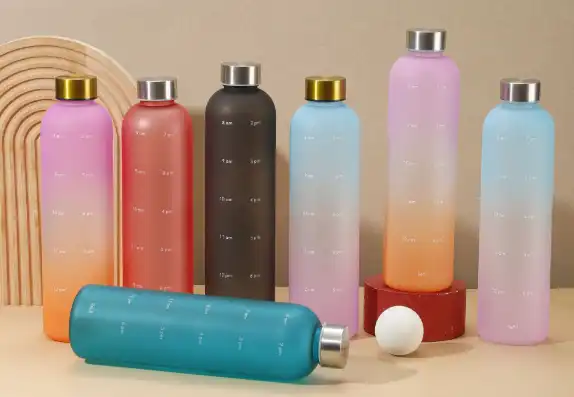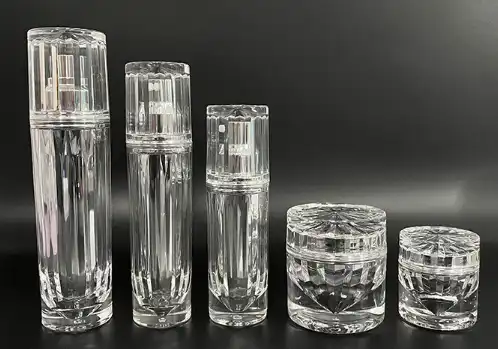Earlier we introduced the production process of plastic mug. Conventional plastic mug is usually made of PP, AS, ABS, acrylic, PET, etc.
The detailed analysis of each material is as follows:
1.PP
PP is the most common plastic lid used on our plastic mug and insulated stainless steel water bottle.

2. AS, ABS
AS and ABS are also used in our plastic mug. AS has better transparency than ABS and has better toughness.

3.Acrylic
Cream bottles, bottle caps, bottle stoppers, gaskets, pump heads, and dust covers that are commonly used in cosmetic containers with thicker walls are injection molded.

Advantages of acrylic
PET material is an environmentally friendly material with high barrier properties, light weight, non-breaking properties, chemical resistance, and extremely transparent. It can be made into pearlescent, colored, magnetic white, and transparent. It is widely used in filling gel water.
Disadvantages of acrylic
This material is an injection-molded bottle with poor chemical resistance. Generally, it cannot be filled with paste directly. It needs to be equipped with an inner tank barrier to prevent the filling from being too full to prevent the paste from entering between the inner tank and the acrylic bottle to avoid the occurrence of turtles. cracks, the packaging requirements are high during transportation, because the scratches look particularly obvious, the permeability is high, and the upper wall feels extra thick, but the price is quite expensive.
How to mold PP injection molding?
Polypropylene (PP) is a lighter type of common plastics. It has excellent electrical properties and can be used as a high-frequency insulation material that is resistant to moisture and heat. PP is a crystalline polymer. When the melt condenses, it exhibits a large shrinkage (1.0%-1.5%) due to large changes in specific volume and high degree of molecular orientation. In the molten state of PP, raising temperature to reduce its viscosity has little effect.
Therefore, during the molding process, the injection pressure and shear rate should be mainly increased to improve the molding quality of the product.
What are the pressures and melt flow processes required at each stage of PP molding?
PP molding mainly includes the mold filling stage, the densification stage, the pressure maintaining stage and the cooling stage. The pressure required for each stage is different, and the melt flow conditions are also different.
1. Mold filling stage
PP is pre-molded and heated and melted in the barrel of the injection molding machine. When injection molding starts, the screw head generates injection pressure until the melt fills the mold cavity. This is a high-pressure and high-speed mold filling process under the action of dynamic pressure. At this time, the flow of high-temperature melt in the mold cavity largely determines the surface quality and physical properties of the product, and the melt flow is affected by the injection pressure and the melt itself.
When the injection pressure is too low, the melt enters the mold cavity slowly. The layer of melt close to the inner wall surface of the mold cavity will increase in viscosity and solidify due to the rapid drop in temperature, and will soon spread to the center, causing the melt to flow. The channel becomes very narrow in a short period of time, which greatly reduces the melt flow entering the mold cavity. As a result, ripples, material shortages, and bubbles appear on the surface of the product.
When the injection pressure is too high, the melt fills the mold too fast and enters the mold cavity in a turbulent flow near the gate, and free injection occurs. The gas in the mold cavity has no time to be discharged, so the surface of the product appears with defects such as cloud spots and demoulding residue. The stress is high and it is easy to produce flash, making demoulding difficult. Although high injection pressure can increase the injection rate and obtain large shearing effects during the injection molding process. Thereby reducing the melt viscosity, but in a physical sense, too high pressure will increase the melt viscosity. This is because as the pressure increases, the distance between the molecular chains is compressed, and the dislocation between the molecular chains It is more difficult, the melt flow is difficult, and the viscosity increases.
Therefore, during the mold filling stage, attention should be paid to grasping the role of high-speed injection molding, that is, high shear rate, rather than blindly increasing the injection pressure. For some high-end products with large wall thickness changes and thick flanges and ribs, multi-stage injection molding should be used to control the shear rate. In actual production, it is generally adjusted to low speed and low pressure first to make the melt enter the mold smoothly; then two different levels of high speed and high pressure are used to make the melt nearly fill the mold cavity and prevent eddy current; finally, one level of low speed and medium pressure is used to avoid overflow. Edges are generated in order to successfully complete the mold filling process.
2. Densification stage
After the mold filling is completed, the rapid flow of PP melt stops and the mold cavity pressure begins to increase. At the same time, the injection pressure also increases rapidly. When the injection pressure reaches the maximum value, the mold cavity pressure does not reach the maximum value. The extreme value of the mold cavity pressure lags behind the maximum injection pressure for a period of time. During this period, the flow process of the melt is a densification process.
During this short period of time, the melt will fill the gaps in all parts of the mold cavity and itself will be compressed. The melt flow rate is very small and the temperature change is not obvious. At this time, the injection pressure is also transferred to the surface of the mold cavity by the melt. , generating cavity pressure (the ease of transfer depends on the fluidity of the melt).
It can be said that the maximum value of injection pressure determines the maximum value that the mold cavity pressure can reach during the injection densification process. As the injection pressure increases rapidly, the mold cavity pressure also reaches the maximum value, and a large kinetic energy impact is generated in the mold cavity, which deforms the mold closing mechanism and mold system of the injection molding machine and slightly expands the mold. Under normal deformation conditions, the mold expands slightly to release air, so injection molding must be performed at a relatively high pressure.
This can not only compress the melt, but also melt the viscous fluid melt that fills the mold cavity from different directions into a whole. However, the injection pressure cannot be too high, otherwise it will cause the product to stick to the mold. After the mold is released, the product will have overflow and swell in size, which will affect the molding quality.
I believe you have a better understanding of the plastic PP cup in your hand. It turns out that there are still many things to go through from mold to product.
As a cup supplier, we will carefully control every step from materials to molds, from semi-finished products to finished products, from finished products to packaging, from packaging to inspection and shipment, and be your eyes in China.






